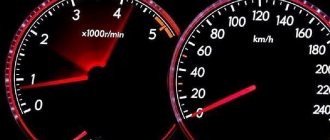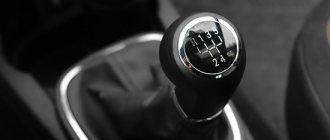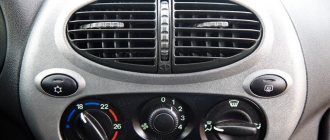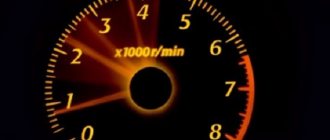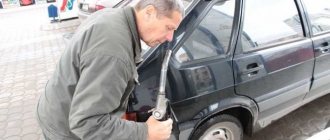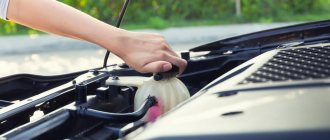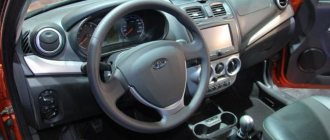It often happens that while driving the VAZ 2110 does not pick up speed well. Thus, driving at low speeds can greatly affect the comfort and safety of driving the car. This problem makes maneuvering and overtaking extremely difficult. That is why such a problem should be corrected immediately.
This problem, in which the VAZ 2110 is not gaining momentum, may have several reasons:
- Problems with air supply to the engine;
- Faulty ignition system;
- Faulty fuel supply system;
- Problems with the exhaust system.
Problems with air supply to the engine
Content
A common reason for poor engine speed can be poor air supply to the engine, because air is needed to prepare the combustible mixture, which sets the engine pistons in motion.
VAZ-2110 engine cooling system: 1 - expansion tank; 2 — radiator outlet hose; 3 - radiator; 4 — radiator steam outlet hose; 5 — radiator supply hose; 6 — casing of the electric fan of the cooling system; 7 — thermostat housing; 8 — coolant temperature sensor of the engine management system (installed in the exhaust pipe); 9 — exhaust pipe; 10 — coolant temperature sensor for the instrument cluster (installed in the cylinder head); 11 — cylinder head; 12 — throttle assembly; 13 — bracket for fastening the supply pipe of the coolant pump; 14 — coolant pump; 15 — supply pipe of the coolant pump; 16 — heater radiator supply hose; 17 — heater radiator outlet hose; 18 — steam removal hose of the heater radiator; 19 — coolant pump supply pipe hose; 20 - filling hose.
If too much air is supplied to the engine, the mixture in it becomes too saturated with oxygen, and the percentage of gasoline in the mixture, on the contrary, drops.
The most optimal and simple method of solving such a problem may be to purchase and install a new air filter. To prevent a similar problem in the future, it is necessary to replace the air filter in the engine 2 times a year.
The VAZ 2110 does not reach speeds above 3.5 thousand.
Up to 3 thousand revolutions it works like a clock, but after that it starts to jerk a lot! The fuel pump, armored lines and ignition unit are new! What could it be? (VAZ injection, 8 valve)
Comments 47
hose for the vacuum tank, how is it doing intact or with holes, look
good idea, thanks)
please ask the author of the topic to share with others how he solved the problem
so I shared it seems that 2 injectors were clogged, and since I was not there I don’t remember which ones (by count), they replaced the injectors and everything became fire)))
then sorry, I must have missed it
This also happened, it turned out that the fuel filter at the bottom was clogged, could not stand it and all the debris got into the injectors, at first it jerked, and then completely stalled. But after it started twitching, I drove another 300 km. Upon arrival home, I changed the filter, cleaned the tank and injectors and forgot about it.
replace the filter that is under the bottom of the car and drive on
How many people, so many opinions. Look at all engine systems one by one from simple to simple. If the check light does not light up, then it is unlikely to be a camshaft sensor, and it does not look like it. Also, if the crankshaft sensor doesn’t work, you won’t start the car. Look at the crankshaft pulley, it was somehow loose, just at speed it got into resonance and the DPKV could not get a normal signal from it. Relevant if you recently climbed into the timing belt. Check the air and pressure in the rail.
Look at the oxygen flow sensor)
Look at the crankshaft pulley, sometimes it even turns the crankshaft gear, look at the synchronization, it will show everything
+100. The key was cut off and the mark moved a little. That’s where the adjustment and lack of speed come from.
I have a piece of paper stuck to the filter in the tank... how the hell it got there, who knows. After 3.5t the car stalled while driving. at idle everything was ok
199% change the DMVR (Preferably BOSCH) in the air intake I had the same thing on a VAZ 21102, changed it and forgot.
Doesn't it stall if you raise the rpm to 4 thousand and hold it?
By the way, the same thing happened to me at ten. I cleaned the ramp and injectors at the same time. and the car flew off
go for diagnostics, what are you thinking... otherwise you will waste extra time, extra money on extra spare parts...
A new pump does not mean it is working, measure the pressure. The sensors most likely have nothing to do with it; they would work in emergency mode if they fail. what fuel system? with return? Look at the pressure reducing valve, and in general measure the pressure in the fuel rail.
Look at the air... If the car operates normally at idle and then at medium speeds, then the TPS, IAC, and crankshaft sensors simply cannot be to blame...
p.s. for those who say that it’s not like that: TPS - the resistor always erases at the beginning (most of its life it is there), and not at the end. IAC - jams in 30-50 steps mode, approximately 880-980 engine rpm. and as soon as you open the throttle by 2%, it no longer participates in the work (you can see it in the steps) Crankshaft position sensor - if it works, it works. If it burns out, it doesn’t work... there is no other option.
p.s. look at the air filter, mass air flow sensor, and excess air intake...
ignition too early
If it jerks in 4th gear, but everything is fine in 1st and 2nd, then there is definitely a problem with the fuel supply, either the fuel pump is not pumping, or the pipes are bent, clogged, etc., or the filter, or the fuel pressure regulator on the ramp , or injectors. If there is not enough air, the car does not jerk, but simply does not gain air. Check the pressure in the frame, there is a special place there, you can just use a tire inflation gun. Look up the pressure value on the Internet. Then look at the fuel pressure regulator, it is controlled by vacuum from the manifold, like a load, maybe the hose is leaking or leaky.
Faulty fuel supply system
One of the common reasons for poor engine speed may be the slow failure of the fuel pump. At first, this problem will not be very noticeable. But in the future the problem will become more and more noticeable. Because the pump will pump fuel into the engine worse and worse, which, in turn, will drop in speed.
The most rational solution to this problem may be to replace the fuel pump with a new one.
Posts 6
1 Topic by max_fil 2016-10-15 15:34:14
- max_fil
- Participant
- Inactive
- Registration: 2013-04-30
- Messages: 42 Thanks : 12
- Car: VAZ 21103
Topic: Resolved: VAZ 2110 8 valves fails and has no traction
Hello Tazavod. I came across this problem. 2110 8 valve injector. Doesn't want to go. It is gaining momentum very poorly, one might say it is not gaining momentum at all. Big failures. Choke or whatever you can call it. I replaced all possible sensors (crankshaft, idle speed, throttle, cleaned injectors, changed spark plugs, armored wires, fuel pump mesh). Nothing helped. Such a strange thing was noticed, under load, in neutral everything seemed to be normal. When driving, when a failure occurs, you press the gas pedal to the floor, it seems to be trying to go, then slowly releasing the gas, it gains momentum. Where to go, what to look for? PS. I didn't measure the compression.
2 Reply from Sergey VAZ 2111 2016-10-15 18:08:09
- Sergey VAZ 2111
- Connoisseur
- Inactive
- Registration: 2013-11-21
- Messages: 513 Thanks : 145
- Car: VAZ 2111
Re: Resolved: VAZ 2110 8 valves have dips and no traction
If this problem suddenly arises, it means there is no compression. You need to check the fuel pressure in the rail. Either the fine filter is clogged, or the pump is tricky, or the check valve is tricky.
Causes
There may be several reasons for the lack of proper speed gain:
- There are problems with the air supply;
- The ignition has failed;
- Fuel system malfunctions have occurred;
- There were problems with the exhaust system.
Fuel system problems are common in gasoline engines. They are the most common. Therefore, you should start with checking it.
Fuel system
If problems arise when accelerating the car, start checking by inspecting the fuel system.
- Most often, the engine stops gaining momentum because the fuel pump fails. At first, this may have a slight effect, sometimes unnoticed. Over time, as the pump wears out, the speed and power will begin to drop, and the acceleration dynamics will decrease.
- If the fuel pump is partially damaged, it still partially performs its functions, but is no longer capable of delivering the same volumes of fuel. This results in fuel starvation and power loss.
- The best solution to a problem with the pump is to replace it. It is better to trust repairs to specialists.
Ignition
If the ignition fails, you will have to conduct a comprehensive check of all system components that may cause a drop in engine power and speed.
What to check
Peculiarities
Checking timing marks
If the marks are installed incorrectly, fuel will not be injected in a timely manner, and the correct frequency of spark supply will be disrupted.
You will have to check all the sensors that take part in the operation of the ignition system. Pay special attention to the crankshaft and camshaft position sensors. A regular test allows you to quickly determine whether the sensors are really to blame
If the belt has been in use on your vehicle for a long time, it may be at the end of its service life. Or it was installed incorrectly when replacing it. After all, it is enough to make a mistake by one tooth, and the performance of the car will be impaired, the car will not be able to accelerate properly
In some cases, they do not allow the car to start at all if there is a malfunction, but sometimes they lead to a noticeable drop in power. Remove them, check their condition, clean them, measure the distance between the electrodes. If they fail, simply replace them with new ones.
To finally verify the presence or absence of problems in the ignition system, it is recommended to conduct more detailed diagnostics.
Diagnostics
We suggest you familiarize yourself with several steps aimed at diagnosing the condition of the ignition system. This may help determine why the engine is not revving up.
- Make sure that the electronic control unit is performing its functions. First of all, turn on the ignition and listen to whether the fuel pump starts working.
- Measure the pressure in the fuel line. If the readings fall within 2.5-3.0 kg/cm3, then everything is fine.
- If the measurement readings are normal, check the BitStop parameter using scan tools while cranking the crankshaft. If the parameter is indicated “no”, then the ECU receives the command to create a spark at the plugs and works well.
- Using a high-voltage spark gap, you can check for the presence of a spark. After all, it’s not uncommon for worn-out, dirty spark plugs to be to blame.
Air supply
It is not uncommon for engine thrust to deteriorate due to a disruption in the normal air supply to create the air-fuel mixture.
If there is more air, the mixture will be lean because the amount of oxygen will exceed the amount of fuel. Hence the drop in power and decrease in traction.
Jerks when cold
Many owners of the VAZ 2110 note that jerks occur when cold, and after warming up, the car gets into a rhythm while driving and stops “sausaging”. The main reason in this case is called a lean mixture, due to the fact that air is sucked in at idle. Or one of the sensors “died”.
If dips often occur when cold (as well as when driving), in addition to everything already listed, you need to check:
- spark plugs - if they have heavy carbon deposits, and even make poor contact with the wires, this needs to be corrected urgently. In the first case - by replacement, in the second, by cleaning and strengthening contacts;
- high voltage wires . Checked with an ohmmeter (multimeter). But if they even look old and shabby, it’s better to just replace them all at once;
- ignition coil . You need to check the armored wires and the ignition module while wearing rubber gloves, otherwise you may get a slight electric shock if there is a break;
- The timing belt can jump a couple of teeth, then when cold there may well be failures. Therefore, check whether the marks on the pulleys match. If not, the belt must be removed and set correctly;
- be sure to check the oxygen sensors (OS); mass air flow (MAF); idle air regulator (IAC), if a malfunction is detected, replace them;
- filters . In principle, they need to be checked first, even before serious damage occurs. Air and fuel filters are designed to give cars a clean mixture. That is, they take on all the debris particles, so they become clogged, worsening the dynamics of the car, and also increasing fuel consumption. They need to be changed regularly.
IF YOU HAVE CHECKED EVERYTHING, TRIED TO FIX IT, BUT NOTHING HELPS, YOU SHOULD ONLY SEEK THE REASON IN THE ENGINE ITSELF.
It is possible that the fuel injectors in a fuel-injected vehicle are clogged. Then you will need professional diagnostics in the service.
You should not miss one more point, because of which, when cold, as well as when driving, metamorphoses such as twitching can occur with the car: did you put the right gasoline in it? Advice to all car enthusiasts is always relevant: if possible, refuel at a reliable, proven gas station. Low-quality fuel can not only cause jerking, but also damage not only the fuel pump, but the entire engine.
Causes of poor speed gain
General view of the engine under the hood
So, let's look at what the problem is and where exactly you need to look for it:
- Fuel pump and pressure.
- Injectors.
- Fuel rail.
- Ignition system.
- Electronic control unit.
Now that all the causes are predetermined, you can begin sequential diagnosis and methods for solving the problem.
Options for solving the problem
To diagnose all of the above systems you will need a set of wrenches and screwdrivers, a tester, a little knowledge and hands growing from the right place. The main task remains to correctly distribute the sequence of operations. This is exactly what we will talk about next. So, let's look at where we need to go to remove the effect that has arisen.
Fuel pump, filter, rail and injectors
Fuel pump in the process of disassembly and diagnostics
First of all, for diagnostics it is necessary to diagnose the gasoline module (pump). If the car drives at high speeds, then everything is fine with the pump itself, but the problem may lie in the filter mesh . For inspection, you will have to remove the fuel pump and replace the cleaning screen on it, which is primarily responsible for purifying gasoline. Most likely, it is dirty and needs to be replaced.
General view of the fuel filter
The second problem may be the fuel filter, which needs to be replaced. It is often dirty and needs to be replaced. After the first two elements of the fuel system have been replaced, you can try to drive it and see if the problem goes away.
General view of the fuel rail with injectors
If, nevertheless, the car continues to gain momentum poorly, then you need to crawl under the hood and look for the problem directly in the fuel injection system. To do this, you need to measure the pressure in the fuel rail.
To do this, dismantle the fuel rail with injectors and disassemble the assembly. The first element must be checked for leaks. Injectors are often installed on a special stand, cleaned and diagnosed. If necessary, all damaged elements are replaced.
Ignition
Unscrewing the spark plugs from the engine
If the fuel system has been checked and is working properly, then you need to look for a problem in the ignition system. So, the high-voltage wires are dismantled and the spark plugs are unscrewed. Both elements are checked using a tester . Of course, it is best to diagnose spark plugs on a special spark plug stand. As practice shows, the problem in 50% of cases lies precisely in this unit, so after checking it is necessary to replace the damaged elements. We conducted a special survey on the choice of candles.
ECU error codes
If all of the above reasons are eliminated and the components are working properly, then most likely the firmware has failed or a critical number of ECU errors have accumulated.
To eliminate the cause, you need to connect the laptop to the engine control unit and carry out diagnostics.
As practice shows, the problem is generally resolved by replacing the software. Instead of standard software, many motorists install Paulus products, although most simply reset the settings to factory settings.
Reading ECU errors using the instrument panel
Causes
There may be several reasons for the lack of proper speed gain:
- There are problems with the air supply;
- The ignition has failed;
- Fuel system malfunctions have occurred;
- There were problems with the exhaust system.
Fuel system problems are common in gasoline engines. They are the most common. Therefore, you should start with checking it.
Fuel system
If problems arise when accelerating the car, start checking by inspecting the fuel system.
- Most often, the engine stops gaining momentum because the fuel pump fails. At first, this may have a slight effect, sometimes unnoticed. Over time, as the pump wears out, the speed and power will begin to drop, and the acceleration dynamics will decrease.
- If the fuel pump is partially damaged, it still partially performs its functions, but is no longer capable of delivering the same volumes of fuel. This results in fuel starvation and power loss.
- The best solution to a problem with the pump is to replace it. It is better to trust repairs to specialists.
Ignition
If the ignition fails, you will have to conduct a comprehensive check of all system components that may cause a drop in engine power and speed.
What to check
Peculiarities
Checking timing marks
If the marks are installed incorrectly, fuel will not be injected in a timely manner, and the correct frequency of spark supply will be disrupted.
You will have to check all the sensors that take part in the operation of the ignition system. Pay special attention to the crankshaft and camshaft position sensors. A regular test allows you to quickly determine whether the sensors are really to blame
If the belt has been in use on your vehicle for a long time, it may be at the end of its service life. Or it was installed incorrectly when replacing it. After all, it is enough to make a mistake by one tooth, and the performance of the car will be impaired, the car will not be able to accelerate properly
In some cases, they do not allow the car to start at all if there is a malfunction, but sometimes they lead to a noticeable drop in power. Remove them, check their condition, clean them, measure the distance between the electrodes. If they fail, simply replace them with new ones.
To finally verify the presence or absence of problems in the ignition system, it is recommended to conduct more detailed diagnostics.
Diagnostics
We suggest you familiarize yourself with several steps aimed at diagnosing the condition of the ignition system. This may help determine why the engine is not revving up.
- Make sure that the electronic control unit is performing its functions. First of all, turn on the ignition and listen to whether the fuel pump starts working.
- Measure the pressure in the fuel line. If the readings fall within 2.5-3.0 kg/cm3, then everything is fine.
- If the measurement readings are normal, check the BitStop parameter using scan tools while cranking the crankshaft. If the parameter is indicated “no”, then the ECU receives the command to create a spark at the plugs and works well.
- Using a high-voltage spark gap, you can check for the presence of a spark. After all, it’s not uncommon for worn-out, dirty spark plugs to be to blame.
Air supply
It is not uncommon for engine thrust to deteriorate due to a disruption in the normal air supply to create the air-fuel mixture.
If there is more air, the mixture will be lean because the amount of oxygen will exceed the amount of fuel. Hence the drop in power and decrease in traction.
The easiest way to solve an air supply problem is to replace the air filter. In order to prevent and prevent problems from occurring, this element should be changed twice a year.
Checking the mass air flow sensor
If the engine speed increases, but the speed does not increase, there are several possible explanations for this phenomenon:
- The pressure in the fuel system is too low;
- The operation of the mass air flow sensor is disrupted. The sensor most often returns to its previous performance after cleaning. If it doesn't help, replace it;
- The air filter is clogged. It is better to replace it;
- The nozzle is clogged. This is mainly due to the low quality of the fuel you fill your car with.
Material on topic:
— Checking the mass air flow sensor on a VAZ 2110 with your own hands
Exhaust system
Much less often, a drop in power and speed can be caused by problems with the exhaust system.
Why does the VAZ 2110 jerk when driving?
The phenomenon, which car enthusiasts call jerking, occurs due to a sudden change in the crankshaft speed when the gas pedal is in a stable pressed position. If suddenly a VAZ 2110 jerks while driving, this causes anxiety and concern to the car owner.
We need to do something urgently, but first we need to understand the reason. We will talk about some features of jerks and signals that help you understand why they occur.
During the start
Most often, when starting from a standstill, the highest stage of the jerk is observed - failure, that is, a very significant delay in the engine’s response to the pressed gas pedal. It happens that the engine stalls. It’s especially unpleasant when you’re standing, for example, in front of a traffic light, and someone behind you is already honking, and you’re frantically starting the car again.
A jerk when starting off occurs when the ECU (electronic control unit) gives a signal to start opening the throttle valve, that is, when transitioning from the XX mode to the driving mode.
Throttle position sensor
IN THIS WAY, THE QUANTITY OF FUEL SUPPLY THROUGH THE INJECTORS SHOULD INCREASE, WHICH DOES NOT OCCUR WHEN THE PRESSURE IS INSUFFICIENT IN THE FUEL LINE.
Potential culprits for the car moving jerkily when starting off:
- fuel pump , which is about to completely fail. This is evidenced by its peculiar periodic “howling” or an increase in its noise. The pump on an injection engine is listened to even before the engine itself is started - it is turned on initially from the battery, starting to pump fuel before turning on the starter. It is located inside the gas tank, so it becomes almost inaudible once the engine is running. In carburetor cars, the fuel pump is under the hood, you can hear it even when the engine is running;
- The fuel pump mesh is clogged with foreign particles that enter the gas tank along with low-quality gasoline at the gas station, or are formed in the tank itself due to condensation. This is why the gas tank should be flushed periodically;
- fuel filter , which is located under the hood. It also needs to be changed periodically;
- pressure regulator To replace it, you will need to remove and disassemble the fuel pump.
The first step is to check what pressure the fuel supply system produces. The check is carried out using a pressure gauge. It connects to a fitting located on the fuel rail (under the hood). We cannot give uniform readings, since it is different on different engines.
For some, a pressure below 325 kPa can be considered normal, while for others it is 400 kPa. That is, you need to look specifically at your instruction manual.
If the pressure gauge readings are too high, it means there is a malfunction in the fuel pressure regulator. If the readings are too low (less than 284 or 364 kPa, again, depending on the engine), replacing the fuel filter will help.
While driving
It is also an unpleasant situation when the car has jerks and dips during acceleration. This can happen both when driving and when starting off. A particularly unpleasant, or even dangerous, situation can arise while driving, for example, when a car is about to overtake, and then there is a sudden failure.
The causes of jerks during acceleration can be both those already mentioned and slightly different ones:
- If you have a carbureted car that jerks when accelerating, this may indicate that the ignition is too early. You need to set the lead angle. And checking the ignition timing is quite simple: at speed 4, accelerate to 50 km/h and brake sharply. If detonation lasts 1-2 seconds, then the ignition is set perfectly, the reason is not there;
- on “injectors” everything is controlled electronically. There, the jerking while driving and during acceleration may be due to the mixture being too lean. But this should be shown by diagnostics in the service. If the sensors “know about this, but are silent,” then it is quite possible that they themselves are faulty and must be replaced.


